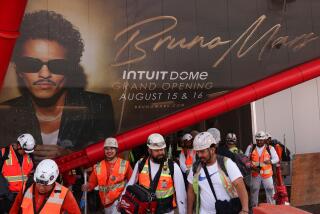Apollo missions to the moon set the stage for InSight’s mission to Mars
- Share via
On Monday, after a seven-month interplanetary journey, Mars InSight will touch down on the Red Planet. There, the lander — which resembles an oversized bug with solar-paneled wings — will embark on a groundbreaking mission to explore Mars’ interior.
Scientists are eager to get a glimpse inside a planet that isn’t Earth. But this will not be first time they’ve peeked under the hood of another object in the solar system.
The Apollo missions first did that nearly 50 years ago on the moon.
After Neil Armstrong took his famous first steps on July 20, 1969, Buzz Aldrin hauled two pieces of luggage out of the Eagle and unpacked them on the lunar surface. One contained a seismometer for recording meteorite impacts and moonquakes. The other was a reflector, off which scientists could bounce a laser beam to precisely measure the moon’s distance from Earth and track its movements to learn more about its composition and structure.
The seismometer failed after a few weeks, but not before recording more than 100 meteorite strikes — and how they reverberated through the moon’s internal layers. Astronauts brought additional instruments on every subsequent moon landing, including heat probes that they drilled into the ground. They even set off grenades to shake the ground in certain spots and study the crust.
The Apollo experiments beamed data back to Earth for the better part of a decade and gave researchers an unprecedented picture of the lunar interior, said Renee Weber, a planetary scientist at NASA’s Marshall Space Flight Center in Huntsville, Ala. They “formed the foundation of our knowledge of seismology on other planets,” she said.
Now, scientists want to know how the inside of Mars compares.
InSight, which stands for Interior Exploration Using Seismic Investigations, Geodesy and Heat Transport, will take many of the same measurements as the Apollo experiments did on the moon. But there is one key difference, said Weber, who is also a member of InSight’s science team: “On Mars, we don’t have the luxury of a human being, so all of that has to be done robotically.”
For that, NASA engineers gave InSight a mechanical arm, which it will use to place the seismometer and its protective windshield on the Martian surface. It will also deploy a self-hammering heat probe, which will dig itself into the ground next to the lander.
If those instruments work as planned, they will give researchers crucial new data in their understanding of how rocky bodies form and evolve.
“It’s going to be eye-opening to finally get some information about a planet beyond the Earth-moon system,” said Suzanne Smrekar, a geophysicist at NASA’s Jet Propulsion Laboratory in La Cañada Flintridge and the deputy principal investigator for the InSight mission.
Conveniently, Mars represents an intermediate example between the Earth and the moon. It falls squarely in the middle, in terms of size. And although all three bodies formed at about the same time, they represent different stages of planetary evolution.
Earth has a fresh, young face thanks to constant geologic makeovers by volcanoes and plate tectonics, processes driven by the planet’s ample internal energy. In contrast, heat probes on the Apollo missions confirmed that the moon’s crater-riddled crust is cold and dead.
Mars is probably somewhere along that spectrum. Volcanoes have erupted in the not-so-distant past, but scientists suspect the planet has likely aged beyond its rambunctious youth. InSight’s heat-flow measurements will try to ascertain whether that suspicion is correct.
“The idea is really to understand a planet’s evolution for billions of years,” said Anne Pommier, a planetary scientist at UC San Diego who is not involved in the mission.
Researchers also want to understand how the insides of rocky planets differ.
The Earth, moon and Mars all formed through violent collisions and separated into the same basic layers of core, mantle and crust as they cooled. But we know that Earth has fairly complex internal structure, due to the greater temperatures and pressures in its interior and to the vigorous convection of the mantle. The Apollo experiments, on the other hand, showed the moon’s layering to be relatively simple.
When it comes to Mars, scientists again expect to find something in between.
“If we can learn about the internal structure of Mars, that is just another building block in the backstory of terrestrial planet evolution,” Weber said.
Finally, researchers hope to study the cores of planets. Earth has a large core, in which metallic liquid roils, creating a magnetic field that shields our atmosphere and makes life possible. A recent re-analysis of Apollo data — led by Weber — suggests that the moon has a tiny core. The Apollo experiments also confirmed that, though the lunar core may have produced a magnetic field in the past, it doesn’t support one now.
Mars has undergone a similar transformation. It lost its magnetic field long ago, and with it, the planet’s best chances of habitability. Scientists hope InSight will help them figure out why by revealing the size and current state of the Martian core.
At first blush, the Earth, the moon, and Mars appear to have a lot in common.
“They underwent the same process early in their history,” Pommier said. But then, for reasons scientists don’t fully understand, “they took different pathways.”
As far as we know, only one led to life.







